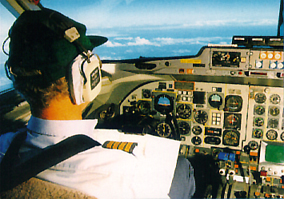Flying to remote places

The job of the New Zealand Flight Inspection Team is to make sure that planes can get to where they are going quickly and safely. The team checks on navigational aids, like radio beacons and runway landing systems, and the condition of the airports and airfields aircraft use. Their work sometimes takes them to out-of-the-way places in the Pacific region, such as the scattered islands of Kiribati, near the equator. A team member recalls one visit he made.
Kanton Island in Kiribati was an old wartime airbase. In 1990, the United States asked us to inspect a beacon there so that Kanton could be used as an emergency alternative for planes flying from Honolulu to Christmas Island. They also wanted us to take samples of the reserves of jet fuel in forty-four-gallon drums at the airfield.
It must have been years since a plane had been there, so when we arrived, we made three low passes over the runway to have a look at it. There could have been bikes, farm animals, shovels, wheelbarrows, all sorts of things on the runway. So we flew along it low, with everybody looking out the windows to check that it was all clear. Then we landed. Well, the kids just ran straight out around the plane. We were using a Fokker Friendship at the time – a propeller-driven plane – so we had to get the propellers stopped in a hurry. Most of the kids had never seen a plane before. The adults had, and they were very keen to welcome us. There hadn't been a supply ship in the place for more than a year. They were quite short of food and were living mainly on fish and coconuts. They all came on board the plane and absolutely cleaned us out. None of those kids had seen commercially made biscuits before. We asked for some coconuts, and the kids shinned up the palm trees and got some.
All the old airfield buildings were still there; it was like the Marie Celeste – log books opened on the desk, technical equipment... There was a well, and a pump. The pump looked brand new. Then we noticed that the drive-belt had rotted away in the sun. It had been there for years.
It was pretty hot, so the crew decided to go for a swim in the lagoon. The locals went crazy and ran over to watch us. We said, "Haven't you seen people swimming before?"
Well, not here," they said. "It's full of sharks!"

